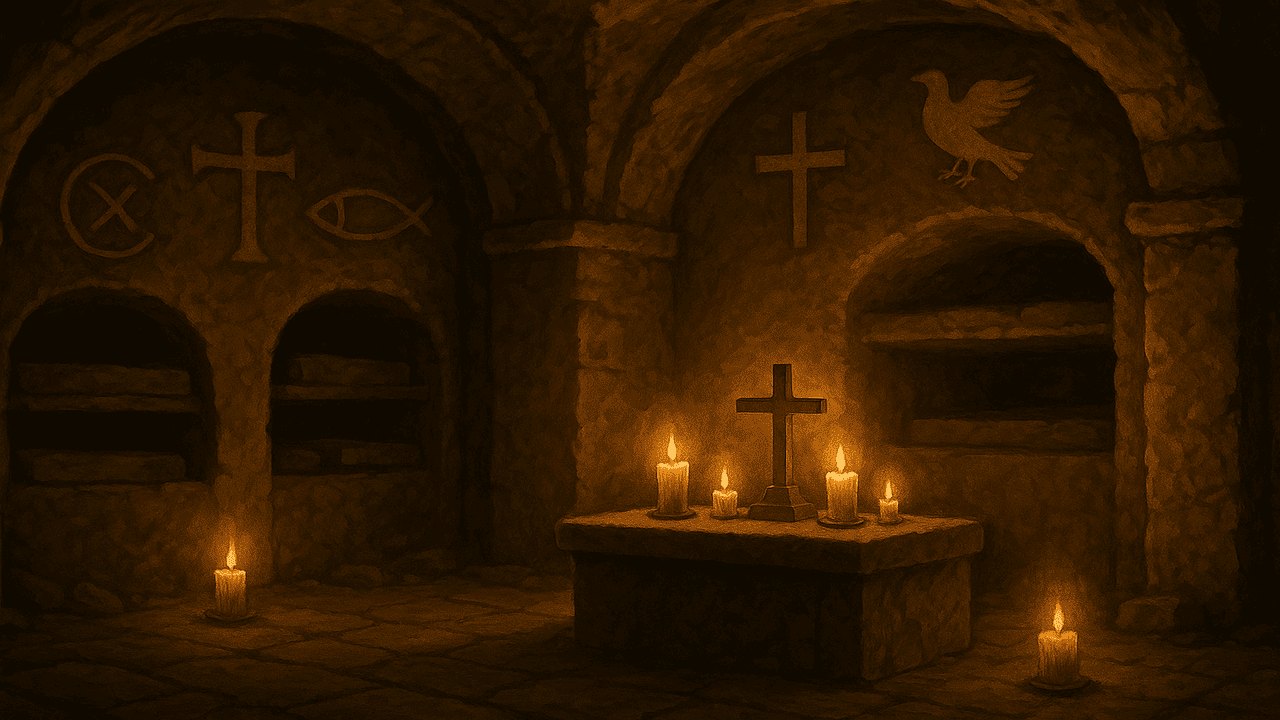
Thorn Ville Church – Long before the grand basilicas of Vatican City and the ornate chapels of Renaissance Rome, the earliest Christians sought refuge not in sunlight, but in shadow. Hidden beneath the bustling Roman Empire, the Catacomb Churches of Rome stand as silent witnesses to a time of danger, devotion, and deep faith.
These underground networks were not simply burial grounds. For many early Christians, they were sacred spaces of worship, fellowship, and spiritual defiance. Far from the public squares and marble temples of ancient Rome, these catacombs offered a quiet resistance places where faith could breathe even when forbidden.
The word catacomb comes from the Latin cata tumbas, meaning “among the tombs.” While originally referring to a specific area outside Rome on the Appian Way, it eventually came to describe any subterranean burial site.
The Roman catacombs were developed between the 2nd and 5th centuries AD, a time when Christianity was still a minority faith and often persecute by Roman authorities. Because of this, Christians avoided public gatherings and created their own spaces deep underground, often in soft volcanic rock called tuff, which was easy to carve yet stable enough for tunnels and chambers.
Also Read : The Church of the Holy Sepulchre, Jerusalem A Sacred Site
While the primary purpose of the catacombs was interment of the dead, many sections were used as places of worship, especially during periods of intense persecution like under Emperors Nero, Decius, or Diocletian.
In these candle-lit spaces, early believers gather to pray, conduct the Eucharist, and share stories of the martyrs who were often buried nearby. These catacomb churches of rome were rudimentary chapels, carved into rock and decorated with Christian symbols fish, anchors, loaves of bread, doves, and the Chi-Rho.
Notable examples of catacomb churches include:
These sites served as both spiritual homes and historical archives for early Christianity.
The very act of building and worshipping in these catacombs was a form of protest and resilience. At a time when attending a Christian gathering could mean arrest or worse these communities chose faith over fear. The walls of the catacombs are fill not only with tombs but with hopeful messages, brief inscriptions, and symbols of resurrection.
What stands out is the absence of fear. Rather than emphasizing death, catacomb art focused on eternal life portraying stories like Jonah and the whale, the Good Shepherd, or the raising of Lazarus. These were not just decorations; they were visual affirmations of belief that death was not the end.
Also Read : 5 Ways to Help Children Build Resilience!
After Christianity was legalize in the early 4th century by Emperor Constantine, many of the catacombs gradually fell out of use. For centuries, they were forgotten until being rediscover in the 16th and 17th centuries, largely thanks to archaeologists and Church historians.
Today, the Vatican and Italian authorities manage and preserve many of these sites. Visitors from around the world can tour parts of the catacombs with guides, learning about the lives of early Christians who once worshipped there in secret.
Rather than concluding with modern reflections, let us shift our focus to a question that echoes from below:
What are we willing to do for what we believe?
For early Christians, the answer was clear. They chose narrow tunnels over wide streets. Whispered prayers over public sermons. Stone benches over golden altars. And in doing so, they laid the foundation for a faith that would one day emerge from the shadows.
In the silence of these Catacomb Churches of Rome, one can still sense that bold, unshakable hope a legacy etched in stone and sealed beneath the soil of Rome.
Thornville Church - Your Source for Biblical Inspiration - Historians now highlight how women in early church shaped theology, leadership,…
Thornville Church - Your Source for Biblical Inspiration highlights how church orientation toward east shapes Christian worship, architectural symbolism, and…
Thornville Church - Your Source for Biblical Inspiration reports that recent necropolis discoveries at Colossae are reshaping how scholars read…
Thornville Church - Your Source for Biblical Inspiration highlights how oldest church sites 2025 continue to stand as living testaments…
Thornville Church - Your Source for Biblical Inspiration highlights how ancient churches and sites continue to attract pilgrims, travelers, and…
Thornville Church - Your Source for Biblical Inspiration Growing schedules push many parents to seek simple guidance, and daily bible…